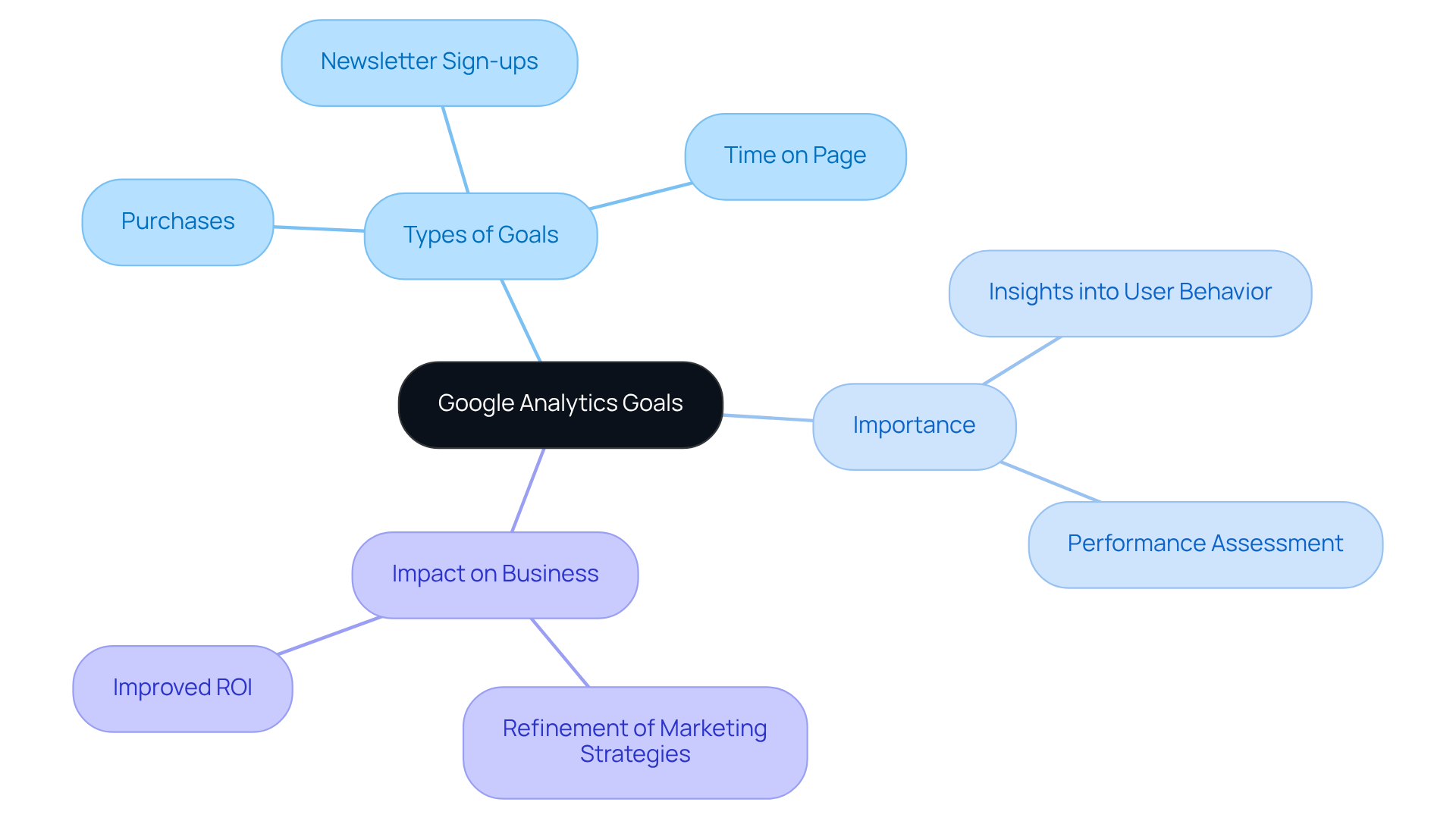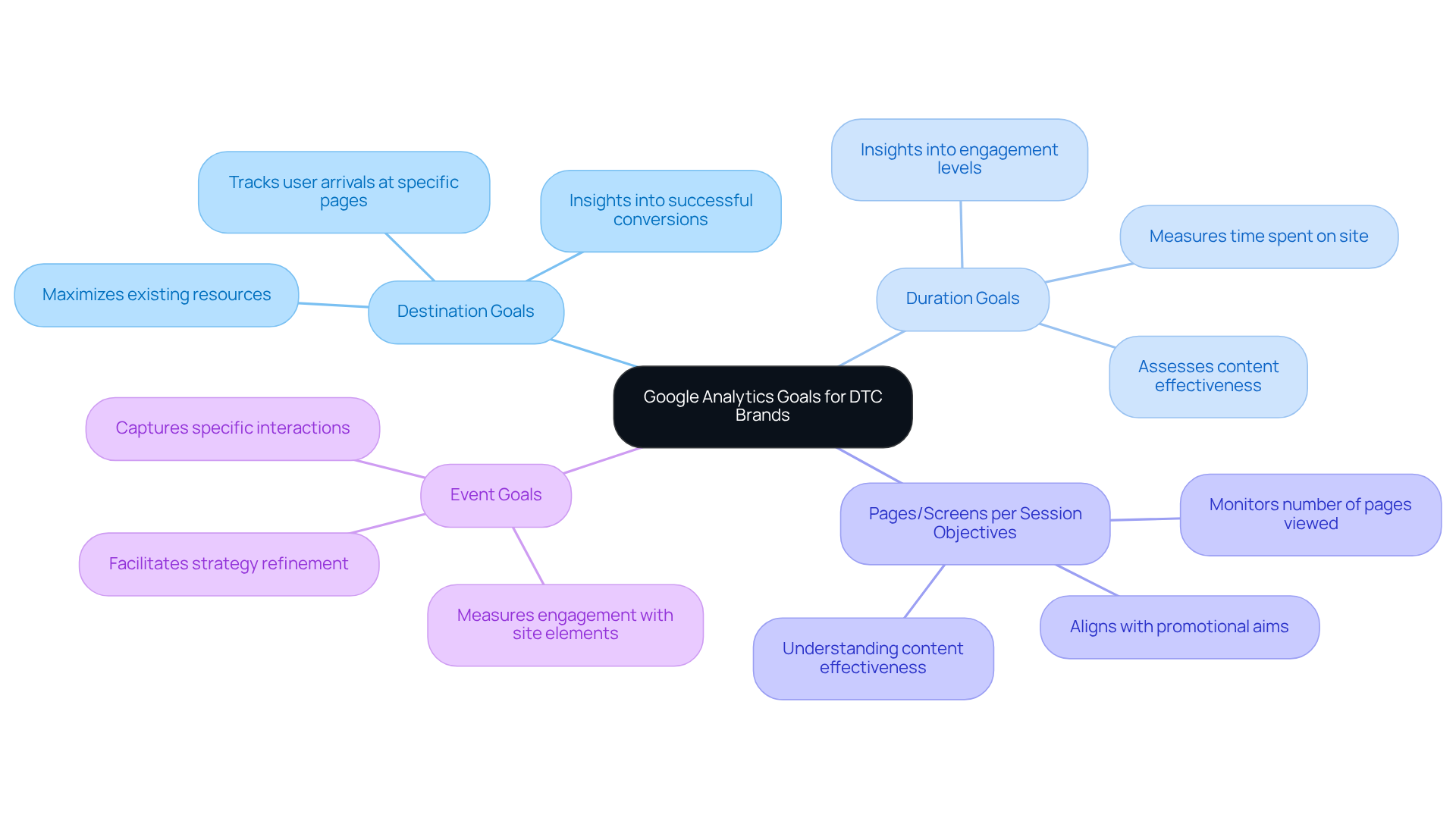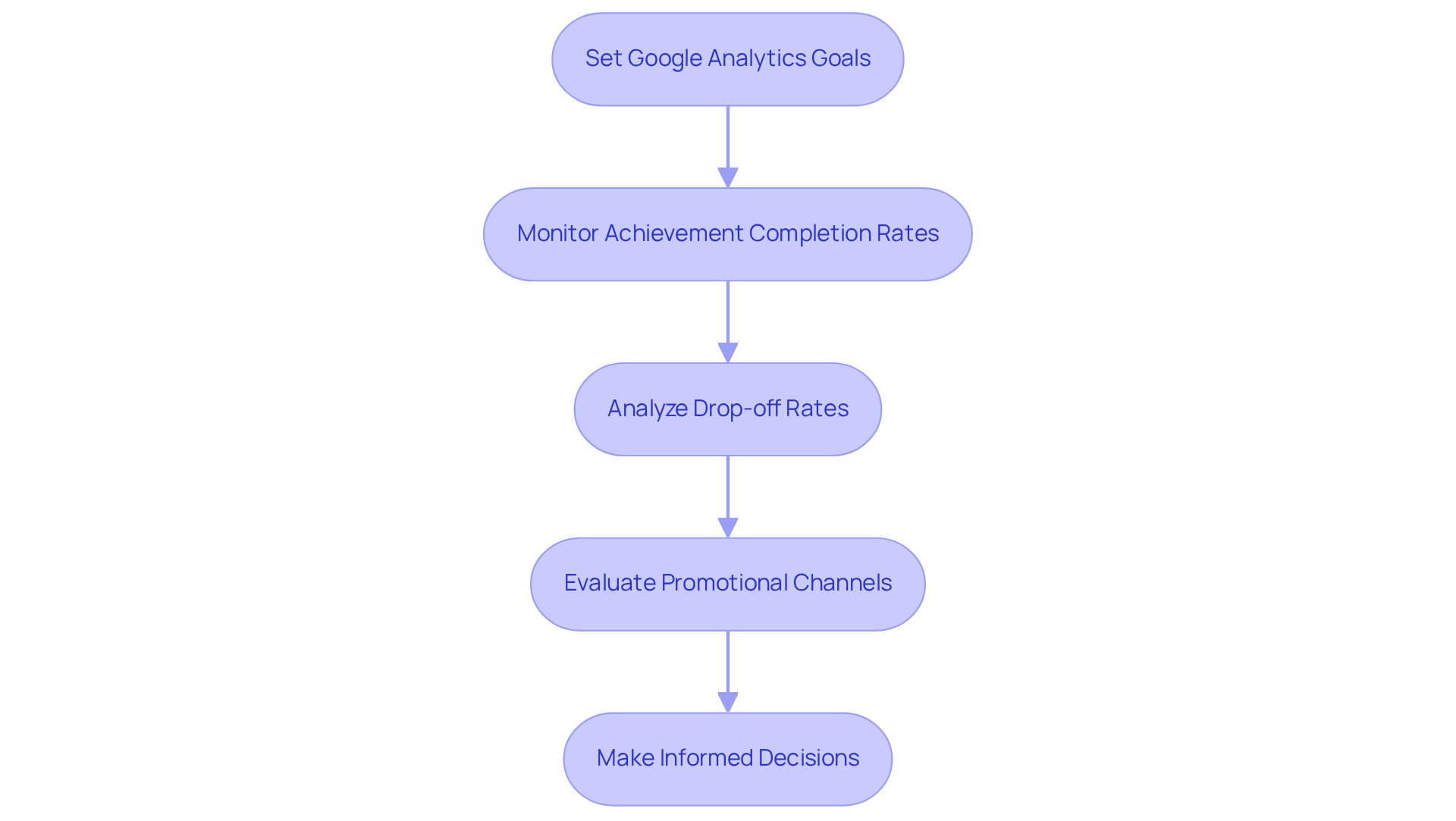
Overview
The significance of Google Analytics goals for Direct-to-Consumer (DTC) brands cannot be overstated. These objectives are pivotal in tracking user actions and conversions, serving as a cornerstone for success in today's competitive market. By defining clear goals and diligently monitoring their achievement, DTC brands unlock valuable insights into user behavior and marketing effectiveness. This process ultimately empowers them to make informed decisions that enhance profitability and drive growth.
Incorporating Google Analytics into their strategy allows DTC brands to analyze data effectively, revealing patterns and trends that inform future marketing initiatives. As brands gain clarity on their performance metrics, they can refine their strategies to better align with consumer needs and preferences. This adaptability not only fosters customer loyalty but also positions brands for sustained success in an ever-evolving landscape.
In conclusion, the implementation of well-defined Google Analytics goals is essential for DTC brands aiming to thrive. By leveraging these insights, brands can navigate the complexities of the market with confidence, ensuring that every decision is backed by data-driven analysis. This strategic approach is key to unlocking the full potential of their marketing efforts, ultimately leading to enhanced profitability and growth.
Introduction
Understanding user behavior is essential for any brand aiming for success in the digital landscape, particularly for Direct-to-Consumer (DTC) brands. Google Analytics goals are a powerful tool that enables these brands to track specific user actions and conversions that directly influence their bottom line. Yet, the challenge extends beyond merely setting these goals; it involves effectively leveraging them to enhance marketing strategies and drive growth.
How can DTC brands ensure that their Google Analytics goals align with their business objectives and yield tangible results?
Define Google Analytics Goals and Their Importance
Google Analytics objectives represent specific user-defined actions that website owners monitor as conversions. These actions may encompass completing a purchase, signing up for a newsletter, or spending a predetermined amount of time on a page. Establishing these objectives is significant due to their ability to provide insights into user behavior and the effectiveness of promotional strategies.
By measuring the frequency of these objectives being achieved, DTC brands can assess their performance and make informed decisions to enhance their online visibility and profitability. Furthermore, objectives aid companies in identifying which features of their website are effective and which require improvement, ultimately leading to a better ROI on promotional activities.
At Parah Group, we recognize that a continuous CRO program, supported by clearly defined Google Analytics goals, empowers data-informed decisions that directly facilitate business growth while reducing customer acquisition costs and enhancing profitability. Our unique approach includes a tailored onboarding process and ongoing support, ensuring that DTC companies can efficiently refine their marketing strategies, resulting in sustainable growth.

Explore Types of Google Analytics Goals Relevant to DTC Brands
In the realm of DTC brands, understanding the various types of Google Analytics goals is essential, particularly when integrated into a robust Conversion Rate Optimization (CRO) strategy.
-
Destination Goals are pivotal, tracking user arrivals at specific pages, such as a thank-you page post-purchase. This not only provides insights into successful conversions but also aids in maximizing existing resources.
-
Duration Goals are equally crucial; they measure the time users spend on a site, offering insights into engagement levels. This metric is vital for assessing content effectiveness in retaining visitors, a key driver for significant growth.
-
Pages/Screens per Session Objectives monitor the number of pages a user views in one session. This data is invaluable for understanding content effectiveness and user engagement, aligning seamlessly with the organization’s promotional aims.
-
Event Goals capture specific interactions, such as video plays or button clicks. These metrics enable companies to measure engagement with critical site elements, facilitating strategy refinement through rigorous testing.
Each category of objective serves a distinct function and can be strategically applied to align with the company's overarching promotional goals. By leveraging these objectives within a comprehensive and data-informed CRO framework, DTC companies can significantly enhance their success rates and profitability, ultimately aligning with their Google Analytics goal. This strategy not only optimizes the alignment of paid ads and landing pages but also drives substantial growth through continuous testing and optimization.

Implement and Track Google Analytics Goals for Optimal Performance
To implement and track Google Analytics goals effectively, DTC brands must adhere to the following steps:
-
Define Clear Objectives: It is imperative to identify the actions that hold the greatest value for your business, such as purchases or sign-ups. This foundational step aligns with the principles of Conversion Rate Optimization (CRO), which is dedicated to enhancing your website to increase conversions and profitability.
-
The Google Analytics goal is essential for tracking website performance. To establish a Google Analytics goal, navigate to the Admin section, select the appropriate view, and click on 'Objectives' to create new targets based on the types previously discussed. A comprehensive CRO strategy will ensure these targets are in alignment with your overarching growth objectives.
-
Assign Values: For e-commerce platforms, attributing financial values to objectives is essential in measuring the impact of transactions on revenue. This step is crucial as it enables you to assess the effectiveness of your CRO efforts in driving profitability.
The primary focus is to achieve the Google Analytics goal.
- Monitor Performance: Regularly review the Google Analytics goals report to analyze how effectively your site is meeting its objectives. This ongoing analysis is vital for optimizing your marketing strategies and website design, ultimately enhancing user experience and driving conversions. By integrating a data-driven approach, you can continuously refine your strategies to achieve sustainable growth.
![]()
Analyze the Impact of Google Analytics Goals on DTC Brand Success
The influence of Google Analytics goals on the success of DTC companies is profound. By examining achievement completion rates, companies can identify trends and patterns in user behavior.
For instance, a $30M clothing label that collaborated with Parah Group experienced a remarkable 35% increase in sales rates after optimizing their checkout process, a change underscored by monitoring drop-off rates. This illustrates that tracking such metrics can uncover critical issues that warrant attention.
Furthermore, monitoring objectives allows companies to evaluate the effectiveness of various promotional channels. In this case, the clothing label discovered that social media campaigns yielded a higher conversion rate compared to email promotions, prompting a strategic reallocation of resources.
Ultimately, leveraging the Google Analytics goal data empowers DTC brands to make informed decisions that enhance customer experience, optimize marketing strategies, and drive sustainable growth, as evidenced by the successful outcomes achieved by Parah Group's clients.

Conclusion
Understanding and implementing Google Analytics goals is essential for the success of DTC brands. These goals act as benchmarks for user engagement and conversion, enabling businesses to evaluate their performance and refine their strategies effectively. By establishing clear objectives, brands can gain invaluable insights into user behavior, optimize their marketing efforts, and ultimately drive profitability.
Throughout this article, we have explored the significance of various types of Google Analytics goals—destination, duration, pages/screens per session, and event goals. Each type plays a crucial role in measuring different aspects of user interaction and engagement. Furthermore, the process of setting and tracking these goals, along with analyzing their impact, illustrates how data-driven decisions can lead to significant improvements in sales and customer experience.
In conclusion, leveraging Google Analytics goals transcends mere technical execution; it is a strategic imperative for DTC brands pursuing sustainable growth. By continuously monitoring and optimizing these objectives, brands can enhance their marketing strategies, improve user experience, and ultimately achieve greater success in a competitive landscape. Embracing this approach empowers businesses to adapt and thrive, ensuring they remain at the forefront of their industry.
Frequently Asked Questions
What are Google Analytics goals?
Google Analytics goals are specific user-defined actions that website owners monitor as conversions, such as completing a purchase, signing up for a newsletter, or spending a certain amount of time on a page.
Why are Google Analytics goals important?
They provide insights into user behavior and the effectiveness of promotional strategies, allowing brands to assess performance and make informed decisions to enhance online visibility and profitability.
How do Google Analytics goals help in assessing website performance?
By measuring how often these goals are achieved, companies can identify effective website features and areas needing improvement, leading to better ROI on promotional activities.
What is the role of a continuous CRO program in relation to Google Analytics goals?
A continuous Conversion Rate Optimization (CRO) program, supported by clearly defined Google Analytics goals, enables data-informed decisions that facilitate business growth while reducing customer acquisition costs and enhancing profitability.
How does Parah Group support DTC companies in using Google Analytics goals?
Parah Group offers a tailored onboarding process and ongoing support to help DTC companies efficiently refine their marketing strategies, resulting in sustainable growth.
FAQs











